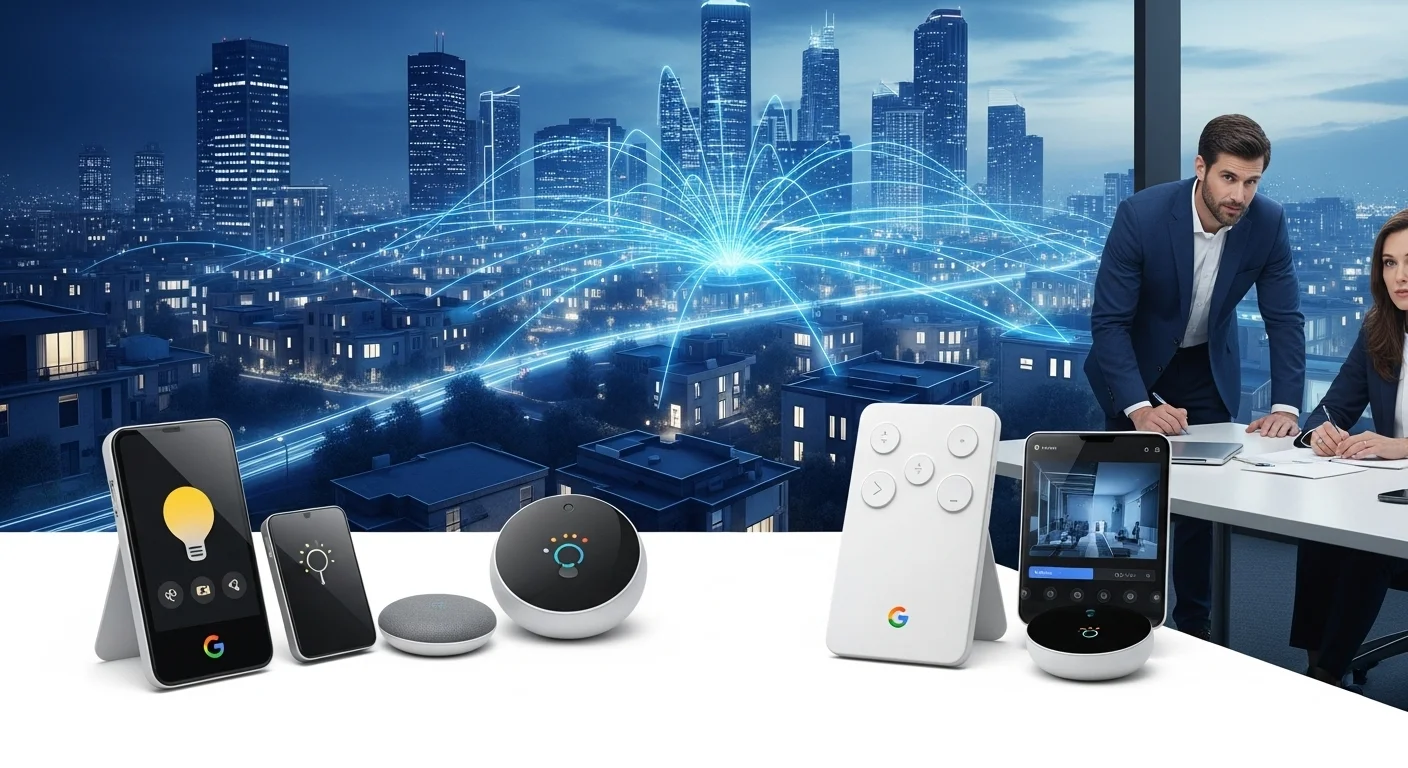Don't Replace, Upgrade: A Guide to Integrating New Tech with Your Existing Systems

Executive Summary
In our fast-paced tech world, it's easy to feel the pressure to always have the latest and greatest. But I've learned from years in this field that true innovation isn't about throwing everything out and starting over. It's about being smart, enhancing the systems you already own and trust. This is true for big companies trying to update their essential software without breaking the bank, and it's just as true for you at home, wanting to make life a bit more convenient with a few smart devices. In this guide, I'll walk you through practical ways to breathe new life into your current technology. We'll look at how to approach these upgrades step-by-step and see how powerful tools like AI and the cloud can work with what you've already got, saving you time, money, and a lot of headaches.
Table of Contents
What is 'Existing Technology' and Why Should You Care?
We're constantly bombarded with news about the 'next big thing' in technology. It’s exciting, but it creates a myth that you always need to be chasing the new. In my experience, the real genius lies in working with what you already have. 'Existing technology' is simply the gear you rely on every day—the software, hardware, and networks that run your business or your home. It’s the foundation you've built, packed with historical data and familiar to everyone who uses it. Honestly, ignoring this foundation is one of the biggest mistakes I see people make. For most of us, starting a tech project from a completely blank slate is a rare luxury. We're almost always building on top of, or connecting to, something that's already in place. Getting this wrong can lead to failed projects, blown budgets, and major security risks. But when you get it right? You unlock incredible value and pave the way for smart, sustainable growth.
In the corporate world, we often talk about 'legacy systems.' This term gets a bad rap, making you think of old, clunky computers from a forgotten era. But these systems are frequently the unsung heroes of a company, handling critical jobs like payroll or inventory that just plain work. The idea of a 'rip and replace' strategy sounds bold, but the cost and risk are often staggering. I've seen it cripple businesses. A much smarter path is modernization. This means we find clever ways to update and connect these older systems to modern platforms using tools like APIs (Application Programming Interfaces). This lets you tap into the power of cloud computing or AI without throwing away the core of your business. It’s also a huge part of cybersecurity. You can't just protect the new stuff; you have to secure your entire setup, especially the older parts that might have well-known weaknesses. It's about putting modern locks on older, but still valuable, doors.
This same idea is completely changing our homes. I remember when creating a 'smart home' meant a massive, expensive rewiring job. Today, it’s a totally different story. The market is full of brilliant devices designed to work with the wiring you already have. Take lighting, for example. Instead of replacing every single light bulb, you can simply upgrade the switch on the wall to a smart one. It’s a simple change, but it's a game-changer. Suddenly, you can control a whole room of lights from your phone, set schedules, or just ask Alexa to do it for you. It's a perfect example of adding a layer of intelligence to your existing setup. From there, you can build out your smart home piece by piece. You might start with light switches, then add a smart thermostat next month, and maybe some smart locks down the line. Each new gadget joins your growing ecosystem, all managed from an app. This step-by-step method is so much more affordable and less overwhelming. The beauty of it is that your smart home becomes a personalized system that fits your life and budget, not some one-size-fits-all package. This has all been made possible by technology designed to be compatible, to work together, creating a home that’s genuinely responsive to you.
The bridge connecting the corporate world and our living rooms is the rise of AI and cloud computing. For a business, weaving AI into its existing software can reveal powerful insights from years of data. The cloud offers a way to give legacy applications a new lease on life, making them more resilient without a complete rewrite. At home, that same AI is the brain behind the voice assistant that runs your smart devices, while the cloud is what lets you check your security camera feed from a beach halfway across the world. In both cases, the new technology isn't replacing what's there; it's making it better, smarter, and more capable. To me, that's the true mark of progress—a thoughtful partnership between the new and the familiar. It’s a more strategic, and ultimately more successful, approach than just chasing shiny objects.

A Practical Guide to Upgrading Your Tech (For Business & Home)
Knowing how to work with the tech you already have is a core skill in our digital world. Whether you're a CTO managing a global company's IT infrastructure or a homeowner looking to make life a little easier, the best approach is always about smart integration, not a total overhaul. This guide offers a clear look at the methods you can use to get the most out of your current systems.
Modernizing Your Company's Bedrock Systems
In business, 'existing technology' often means 'legacy systems.' These systems might feel old, but they are woven into the fabric of the company. Modernizing them is a bit like performing surgery—it requires a delicate touch. There's a well-known framework in my field called the '7 Rs of Modernization' that helps guide this process. The right choice depends entirely on the system's health, its importance to the business, and your long-term goals.
The 7 R's of Modernization: A Simple Breakdown
- Retain: Sometimes, the best move is no move at all. If a system is stable, does its job, and the cost to upgrade is more than the benefit, just leave it be. Don't fix what isn't broken.
- Rehost (or 'Lift and Shift'): This is a popular, low-risk starting point. You essentially pick up your application from its on-site server and move it to the cloud. It's like moving your house to a better neighborhood without renovating it. You get the benefits of the cloud (like reliability) without a major technical project.
- Replatform (or 'Lift and Reshape'): This is a small step up from rehosting. You move the application to the cloud but make a few tweaks to take better advantage of the new environment, like switching to a cloud-native database. The core of the app stays the same.
- Refactor: This is about cleaning up the inside of the application without changing what it does on the outside. You're improving its performance and making it easier to maintain in the future, essentially paying off 'technical debt.'
- Rearchitect: This is a bigger job. You're fundamentally changing the application's structure, often breaking down a large, monolithic system into smaller, more agile 'microservices.' This offers incredible flexibility but requires a lot of work.
- Rebuild: Here, you're rewriting a part of the application from the ground up, but you keep its purpose and function the same. You do this when the original code is simply too old or broken to be saved.
- Replace: This is the most dramatic option. You retire the old system completely and switch to something new, often a commercial software subscription (SaaS). This is the right call when the old system just can't meet the business's needs anymore.
From my experience, the key to success is taking small, steady steps. A technique called the 'Strangler Fig Pattern' is a great way to do this. Imagine a vine growing around an old tree. You build new features around the old system, slowly taking over its functions until the old system is no longer needed and can be safely removed. This process dramatically reduces risk and lets the business see benefits along the way.
Bringing Smart Technology Into Your Existing Home
For homeowners, the challenge is similar: retrofitting smart tech into a house that wasn't built for it. The principles are the same: work with what you have, upgrade in phases, and focus on making everything work together.
A Step-by-Step Guide to a Smarter Home:
- Check Your Foundation: I can't stress this enough: your Wi-Fi network is the backbone of your smart home. Before you buy a single gadget, make sure your router is up to the task and that you have a strong signal everywhere. A weak network is the number one reason for smart home frustration.
- Pick Your Team: While things are getting better, it's still a good idea to align with a primary ecosystem like Amazon Alexa, Google Home, or Apple HomeKit. This makes controlling everything with your voice feel much more natural and seamless.
- Start with a Big Win: Lighting is often the best place to start. Making your current light switches smart is a fantastic first project. It's a clean look, it controls entire light fixtures, and it's intuitive for anyone to use—unlike smart bulbs, which stop working if someone flips the physical switch off. If you're comfortable with basic electrical safety, it's a straightforward DIY job.
- Expand Step-by-Step: Once your lights are smart, keep going! A smart thermostat can save you money on energy bills. A video doorbell adds a layer of security. Smart plugs can bring old lamps or fans into your new smart ecosystem. Each new device makes your system more powerful.
- Create a Little Magic: The real fun begins when your devices start working together. This is when it shifts from remote control to true automation. Create a 'Movie Night' scene that dims the lights and turns on the TV with one command. Or an automation that turns everything off when it sees your phone has left the house.
The main challenge at home is getting devices from different brands to talk to each other. This is where a central hub or a powerful software platform can be your best friend. They act as a universal translator, making sure all your gadgets work in harmony. And please, don't forget security! A strong Wi-Fi password and two-factor authentication on your accounts are non-negotiable for protecting your privacy.

Pro Tips for a Seamless Tech Experience
Getting the most out of your existing technology isn't just about the hardware or software; it's about having the right mindset and a good plan. I've learned over the years that a few key strategies can be the difference between a smooth, integrated system and a chaotic mess. Here are my go-to tips for both business and home projects.
Best Practices I've Learned The Hard Way
These guiding principles are universal. They apply whether you're managing a corporate IT department or just starting your smart home journey.
- Know What You Have First: Before you change a single thing, do a thorough inventory. For a business, this is a deep audit of all your tech, mapping out how everything is connected. For a homeowner, it’s as simple as checking your Wi-Fi signal in every room and knowing which switch controls which light. Don't rush this step—it's the most important one.
- Think Small, Win Big: Avoid the 'big bang' where you try to change everything at once. It's a recipe for disaster. Break your project into small, manageable pieces. In business, that might mean updating one part of an application at a time. At home, it means getting one room right before moving to the next. This lets you learn as you go and see progress early.
- Focus on Connections (APIs): APIs are the universal adapters of the tech world. In business, making them a priority allows your old and new systems to talk to each other and share data. For home users, this means choosing devices that play well with others through platforms like IFTTT or a central hub. It unlocks so much creative potential.
- Build Security in, Not On: Security can't be an afterthought. When you connect new things to old systems, you can create new vulnerabilities. Use multiple layers of protection: secure your network, manage who has access, and encrypt your data. And please, keep everything—new and old—updated with the latest security patches.
- Write It Down: This is the one everyone skips, but it's a lifesaver. Keep notes on the changes you've made and how things are configured. This documentation is gold for future troubleshooting, upgrades, or just for reminding yourself what you did six months ago.
Helpful Tools for Business Transformation
For businesses, several tools are my go-to for modernizing systems. Cloud Migration Services from giants like AWS, Azure, and Google Cloud have incredible toolkits to help plan and execute moves to the cloud. Integration Platforms (iPaaS) like MuleSoft are the essential 'glue' that connects all your different applications, wherever they live. And modern development practices like DevOps are crucial for managing the continuous flow of updates, which reduces risk and keeps you agile. Finally, don't forget Artificial Intelligence (AI). Applying AI models to the mountains of data sitting in your legacy systems can uncover amazing insights about your customers and operations without you having to move the data at all.
Leveling Up Your Smart Home Experience
For home users, once you have the basics down—like smartening up your existing light switches—it's time to make your system more intuitive and reliable. This is where the real magic happens.
- Refine Your Automations: Go beyond simple timers. Use sensors to make your home react to you. A motion sensor can turn lights on when you walk into a room and off when you leave. A door sensor can send an alert to your phone. This makes your home feel truly intelligent.
- Use Your Location (Geofencing): Let your home react to where you are. Have the lights turn on, the thermostat adjust, and the door unlock automatically as you pull into the driveway. It's a small thing that feels incredibly welcoming.
- Master Voice Commands: Take a few minutes to organize your devices into logical rooms and groups in your Alexa or Google Home app. This lets you use natural phrases like 'Hey Google, turn off the living room.' Creating custom routines for complex actions ('Movie Time!') is a huge time-saver.
- Bulletproof Your Reliability: If you have a lot of devices, a mesh Wi-Fi system is a worthy investment for rock-solid coverage. For the true enthusiast who wants ultimate reliability, a local control hub like Home Assistant is the gold standard. It reduces your reliance on the internet, so your automations work even if your connection doesn't.
- Stay Curious and Keep Growing: Tech moves fast. Every now and then, check for new devices or software updates that could improve your system. I often recommend my clients check out sites like The Verge; they do excellent, straightforward reviews and guides on smart home tech that can help you decide what's worth adding next.
Ultimately, the goal is to create a system where all the parts, new and old, work together in harmony. Whether it's your office or your home, a well-integrated environment is more efficient, more secure, and perfectly tailored to you.
Expert Reviews & Testimonials
Sarah Johnson, Business Owner ⭐⭐⭐
The information about upgrading existing tech is solid, but as a small business owner, I'd have loved a few more real-world case studies.
Mike Chen, IT Consultant ⭐⭐⭐⭐
A really helpful article on working with existing systems. It clarified a lot for me, though a couple of the more technical concepts could be broken down even further.
Emma Davis, Tech Expert ⭐⭐⭐⭐⭐
Fantastic article! Incredibly thorough look at modernizing existing tech. It was a huge help for my own work, and I found it perfectly clear.



